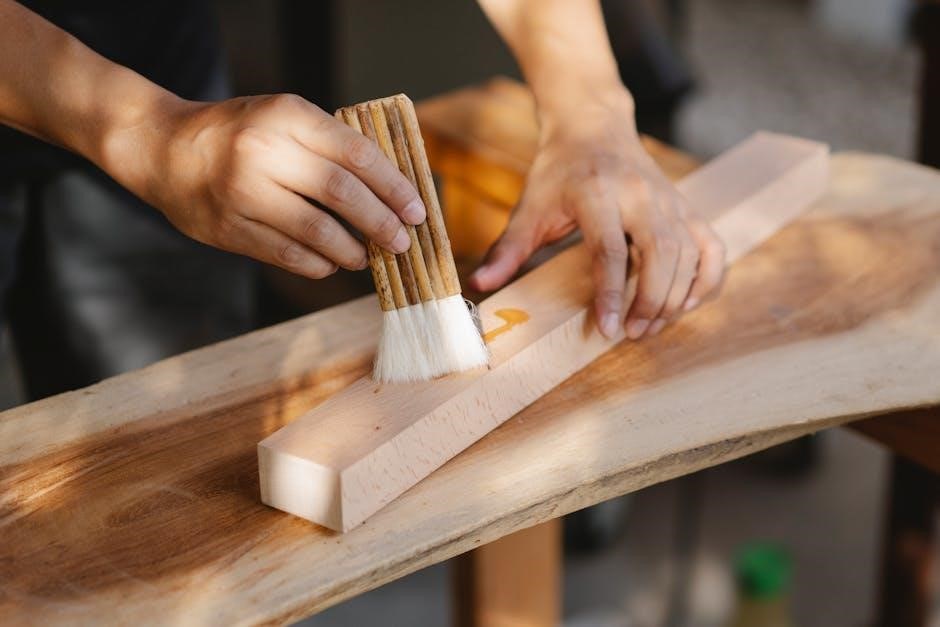craftsman riding mower manual
Welcome to the Craftsman Riding Mower Manual, your comprehensive guide to safe operation, maintenance, and troubleshooting. This manual covers essential topics to ensure optimal performance and longevity of your mower.
1.1 Key Features of Craftsman Riding Mowers
Craftsman riding mowers are known for their robust performance and versatility. They feature powerful engines, durable cutting decks, and automatic transmissions for smooth operation. Models like the T100 Series offer a 36-inch cutting deck and 11.5 HP engine, while others include mulching capabilities and electric start options. These mowers are designed for efficiency, with features like adjustable cutting heights and ergonomic controls. Whether for small or large lawns, Craftsman riding mowers provide reliability and comfort, making yard maintenance easier and more efficient.
1.2 Importance of the Manual for Proper Operation
The manual is essential for understanding and operating your Craftsman riding mower safely and effectively. It provides detailed instructions for assembly, maintenance, and troubleshooting, ensuring optimal performance. By following the guidelines, you can prevent accidents, extend the mower’s lifespan, and maintain warranty coverage. The manual also offers specific safety precautions and operational tips, making it a vital resource for both new and experienced users. Referencing it regularly helps maximize efficiency and safety while using your mower.
Safety Guidelines and Precautions
Always follow safety guidelines to avoid accidents. Disengage blades, wear protective gear, and ensure the area is clear. Refer to the manual for detailed precautions and instructions.
2.1 Essential Safety Rules for Operating a Riding Mower
Always wear protective gear, including gloves and eyewear. Ensure the area is clear of obstacles and bystanders. Keep children and pets away. Never operate the mower under the influence of alcohol or drugs. Disengage the blades and set the parking brake before leaving the seat. Avoid mowing in reverse unless necessary, and use the choke control when starting a cold engine. Ensure the mower is on level ground before engaging the cutting blades. Follow all manufacturer guidelines to ensure safe operation and prevent accidents.
2.2 Pre-Operation Checks to Ensure Safe Use
Before starting the engine, inspect the mower deck for damage or blockages. Check the oil and fuel levels, ensuring they are at recommended levels. Verify that all controls, such as the steering, brakes, and throttle, are functioning properly. Inspect the tires for proper inflation and signs of wear. Ensure the PTO switch is disengaged and the parking brake is set. Remove any shipping braces and check for loose bolts or connections. A thorough pre-operation check helps prevent accidents and ensures smooth operation.

Assembly and Initial Setup
Begin by carefully unpacking and inventorying all parts. Attach the steering wheel and seat, then install the mower deck and other accessories as outlined in the manual.
3;1 Unpacking and Inventory of Parts
Begin by carefully opening the packaging and inspecting for damage. Unpack the mower, steering wheel, seat, and all included accessories. Check for the hardware pack, oil drain sleeve, and operator’s manual. Ensure all listed components match the manual’s inventory list. Verify the condition of each part to avoid missing or damaged items. Organize the parts neatly to streamline the assembly process. Familiarize yourself with the contents before proceeding to ensure a smooth setup experience.
3.2 Step-by-Step Assembly Instructions
Start by attaching the steering wheel using the provided hardware. Next, install the seat and secure it firmly. Connect the battery terminals, ensuring proper polarity. Attach the rear hitch plate and oil drain sleeve as indicated. Follow the manual’s torque specifications for all bolts. After assembling, add the recommended oil and check tire pressure. Double-check all connections and components for proper alignment. Finally, test the mower’s basic functions to ensure everything operates smoothly before first use.

Operating the Craftsman Riding Mower
Start the engine by turning the key and activating the choke. Engage the PTO for blade operation and adjust speed using the control lever. Ensure safe operation by monitoring surroundings and maintaining control at all times.
4.1 Starting and Stopping the Engine
To start the engine, ensure the parking brake is engaged and the ignition key is in place. Turn the key to the “start” position and activate the choke if necessary. Allow the engine to warm up before disengaging the choke. For stopping, disengage the PTO, move to a safe location, and turn the ignition key to the “off” position. Remove the key and ensure the parking brake is set. Always allow the engine to cool before performing maintenance or storage.
4.2 Controlling Speed and Direction
Adjust the speed control lever to set your desired mowing speed. For automatic transmissions, the lever typically controls ground speed, while manual transmissions use a gearshift. To change direction, use the steering wheel gently and smoothly. For sharp turns, reduce speed and avoid sudden movements. Use the brake pedal to slow down or stop, ensuring the mower comes to a complete halt before changing direction. Always maintain control, especially on slopes or uneven terrain, to ensure safe and precise maneuvering.
4.3 Engaging the Cutting Blades and Adjusting Height
To engage the cutting blades, locate the PTO (Power Take Off) lever or switch, usually found on the mower’s control panel. Pull or flip the PTO to activate the blades. For height adjustment, use the deck lift lever or knob to set the desired cutting height, typically between 1-4 inches. Ensure the mower is stationary and blades are disengaged before adjusting. Always lower the deck slowly to avoid sudden movements. Proper height adjustment ensures even cutting and maintains grass health.
Maintenance and Upkeep
Regular maintenance ensures optimal performance and extends the lifespan of your Craftsman riding mower. Perform oil changes, fluid checks, and blade sharpening as outlined in this section.
5.1 Regular Maintenance Tasks for Optimal Performance
Regular maintenance is crucial for your Craftsman riding mower’s performance. Check and change the oil, inspect air filters, sharpen blades, and ensure proper tire pressure. Lubricate moving parts and clean debris from the mower deck. Refer to the manual for specific intervals and procedures. These tasks prevent wear and tear, ensuring efficient cutting and prolonging the mower’s lifespan. Always follow safety guidelines when performing maintenance to avoid accidents.
5.2 Oil Change and Fluid Check Procedures
Changing the oil and checking fluids are vital for your Craftsman riding mower’s longevity. Warm the engine, then locate the oil drain plug and use the provided oil drain sleeve for safe disposal. Refer to the manual for the correct oil type and capacity. Check coolant levels, ensuring the reservoir is filled to the recommended level. Inspect the hydraulic fluid level if applicable. Always follow proper disposal methods for used oil and filters. Regular fluid checks ensure smooth operation and prevent overheating or damage to critical components.
5.4 Sharpening and Replacing the Mower Blades
Sharpening and replacing mower blades ensures clean cuts and prevents damage to your lawn. Disconnect the spark plug before starting. Use a file or grinder to sharpen blades, maintaining a balanced edge. Check for wear or damage; replace blades if necessary. Install new blades securely, ensuring proper alignment. Always refer to the manual for specific instructions and safety precautions. Dull or damaged blades can leave grass torn and vulnerable to disease, so regular maintenance is crucial for a healthy lawn and optimal mower performance.

Troubleshooting Common Issues
Troubleshoot common issues like engine problems or blade malfunctions by identifying symptoms, checking for common causes, and referring to the manual for step-by-step solutions.
6.1 Diagnosing Engine Problems
Diagnosing engine issues in your Craftsman riding mower involves identifying symptoms like difficulty starting, rough running, or overheating. Check for causes such as a clogged air filter, faulty spark plug, or contaminated fuel. Ensure the oil level is adequate and the choke is functioning properly. If the engine stalls unexpectedly, inspect the fuel line for blockages or damage. Refer to the manual for specific troubleshooting steps and recommended solutions to restore engine performance and prevent further damage.
6.2 Resolving Transmission and Steering Issues
Transmission and steering problems in Craftsman riding mowers often stem from worn belts, low fluid levels, or misaligned components. Check the transmission fluid level and top it off if necessary. Inspect belts for cracks or wear and replace them if damaged. For steering issues, ensure the front wheels are properly aligned and the steering gear is lubricated. If the mower struggles to move or steer, consult the manual for specific adjustment procedures or consider replacing faulty parts to restore smooth operation and control.
Warranty and Service Information
This section outlines the warranty coverage for Craftsman riding mowers, including the two-year limited warranty, service options, and requirements for maintaining warranty validity with original parts.
7.1 Understanding the Warranty Coverage
Craftsman riding mowers are backed by a limited two-year warranty, covering defects in materials and workmanship. This warranty applies to the mower and its components, including the engine and transmission, for a period of two years from the date of purchase. Warranty service is free of charge when performed by authorized Sears service centers. To maintain warranty validity, ensure all repairs and replacements use genuine Craftsman parts. For detailed terms and conditions, refer to the warranty section in your manual or contact Craftsman customer support.
7.2 Finding Authorized Service Centers
To locate an authorized Craftsman service center, visit the official Craftsman website or contact their customer support. You can also check the manual for a list of nearby centers. Ensure your mower is serviced by factory-trained technicians using genuine parts to maintain warranty validity. For convenience, schedule service appointments online or call the center directly. Always bring your proof of purchase and warranty documentation when visiting a service center.

Parts and Accessories
Craftsman genuine parts ensure optimal performance. Explore options like rear engine covers, hardware packs, and oil drain sleeves. Visit Sears Parts Direct for authentic components and diagrams.
8.1 Identifying Genuine Craftsman Parts
Genuine Craftsman parts are essential for maintaining your riding mower’s performance. Look for the official Craftsman logo and part numbers on packaging. Visit Sears Parts Direct or authorized service centers to ensure authenticity. Cross-reference part diagrams in your manual to confirm compatibility. Genuine parts are designed to meet specific standards, ensuring durability and safety. Always verify the source to avoid counterfeit products and maintain warranty coverage for your Craftsman equipment.
